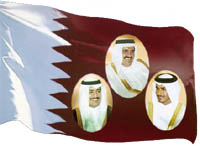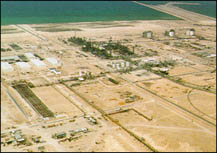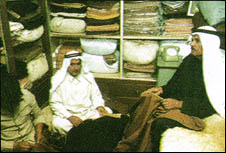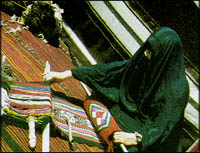The State of Qatar
![]()
 The
Qatari Peninsula juts out like a thumb from the west coast of the Arabian Gulf
and, together with its islands and reefs, covers an area of approximately 11,437
square kilometers, with over 700 kilometers of coastline.
The
Qatari Peninsula juts out like a thumb from the west coast of the Arabian Gulf
and, together with its islands and reefs, covers an area of approximately 11,437
square kilometers, with over 700 kilometers of coastline.
The peninsula itself is roughly 160 km from north to south and at its widest point measures about 80 km from coast to coast. Much of the surface area is covered by stony desert, but there are spectacular dune fields in the south of the country with individual dunes reaching nearly 60 meters, as well as the picturesque Inland Sea ('Khor Al Udaid') - a 'must' for visitors. The highest point in the whole peninsula is only 120 meters above sea level, with naturally eroded limestone plateaux leaving sphynx-like sculptures near to the west coast. The extensive salt flats or sabkha are where the nature lover can find the beautiful gypsum 'desert roses' buried in the sand, and the increasing areas of mangrove are home to a wonderful variety of birdlife.
The
Population and its Distribution
The Central Statistical Office is currently undertaking a census, but estimated figures put the total population at just under 600,000, with around 60% living in the capital Doha, which is the seat of government and the location of the main commercial and financial institutions. A high percentage of expatriates from other Arab countries, Asia, Europe, North and South America, Africa and Australia live alongside a local population with strong historical and family ties to the rest of the Arab states in the Gulf.
 Industrial
areas are located at Mesaieed, (formerly known as Umm Said) south of Doha Salwa,
on the outskirts of Doha, and at the new Ras Laffan Industrial City on the north
east coast. Ras Laffan Industrial City, some 70 km north of Doha, has been built
initially to provide the infrastructure for the development of Qatar's North Gas
Field and whilst production and export of condesates and Liquefied Natural Gas
(LNG) began before the end of 1996, it had its formal inauguration by HH The
Heir Apparent on February 24th 1997. The port, with its long main and lee
breakwaters, is the largest LNG exporting terminal in the world, and new housing
areas are being developed near Al Khor and AL Thakhira, to provide convenient
accommodation for those working in the increasing number of existing and
proposed industries to be based at the industrial city.
Industrial
areas are located at Mesaieed, (formerly known as Umm Said) south of Doha Salwa,
on the outskirts of Doha, and at the new Ras Laffan Industrial City on the north
east coast. Ras Laffan Industrial City, some 70 km north of Doha, has been built
initially to provide the infrastructure for the development of Qatar's North Gas
Field and whilst production and export of condesates and Liquefied Natural Gas
(LNG) began before the end of 1996, it had its formal inauguration by HH The
Heir Apparent on February 24th 1997. The port, with its long main and lee
breakwaters, is the largest LNG exporting terminal in the world, and new housing
areas are being developed near Al Khor and AL Thakhira, to provide convenient
accommodation for those working in the increasing number of existing and
proposed industries to be based at the industrial city.
Al Khor itself is now a thriving town which has developed from an old fishing village. Just under 60 km north of Doha, it has a picturesque harbour with fishing chows, fine beaches, mosques and an old market place, as well as a beautiful Corniche with shaded picnic areas, and a regional museum.
Al Zubarah, on the north west coast, is one of the most important archaeological sites in the country, where excavation work is continuing. The old fort has been transformed into another regional museum. Medinat Al Shamal is a newly developed town at the northern tip of the peninsula, and functions as an administrative center for a number of small villages in the area. Dukhan, on the west coast, gained its importance when oil was discovered in the surrounding areas, and the majority of its residents are employed by the Qatar General Petroleum Corporation (QGPC).
South of Doha is another town, Al Wakra, which has developed from a thriving fishing village. It lies fifteen kilometres from Doha between the capital and the industrial town of Mesaieed which, in addition to its industrial development, has an ever-extending residential area, as well as the distinctive Sealine Beach Resort with its new hotel and superbly landscaped gardens which have brought butterflies and birdsong to the dunes and coastline.
Religion
Islam is the official religion of the country, and the Shari'a (Islamic Law) is the principal source of legislation in the country.
History
 Excavations
indicate that settlements on the peninsula date back to about 8000 BC. For many
years the country was well known for its weaving and embroidery and it was also
a main center for fishing and pearling. The discovery of oil in 1939 came at an
opportune time as the market for natural pearls was declining due to the
Excavations
indicate that settlements on the peninsula date back to about 8000 BC. For many
years the country was well known for its weaving and embroidery and it was also
a main center for fishing and pearling. The discovery of oil in 1939 came at an
opportune time as the market for natural pearls was declining due to the
 development
of the cultured pearl, and many men who had worked at sea could now find new
jobs. Those Qataris whose ancestors were not connected to the sea, fishing and
pearling, come from nomadic Bedouin families who moved camp according to the
seasons tending sheen and camels, and who now had increasing opportunities for
permanent work within the developing economy.
development
of the cultured pearl, and many men who had worked at sea could now find new
jobs. Those Qataris whose ancestors were not connected to the sea, fishing and
pearling, come from nomadic Bedouin families who moved camp according to the
seasons tending sheen and camels, and who now had increasing opportunities for
permanent work within the developing economy.
The
Emir and Government of Qatar
|
Qatar is a sovereign and independent state, which grants hereditary rule within the Al Thani family. The current Emir, His Highness Sheikh Hamad Bin Khalifa Al Thani assumed power on June 27th 1995, the 8th member of the family to have ruled the country. Sheikh Hamad, who was born in Doha in 195O, had increasingly been involved in the running of State affairs prior to 1995, having been appointed as both Heir Apparent and Defence Minister in 1977. In line with the country's amended Provisional Constitution, the Emir's third son, His Highness Sheikh Jassem Bin Hamad Al Thani, was appointed as Heir Apparent on October 22nd 1996. Later that month, the Emir took the step of further amending the constitution to separate the posts of Emir and Prime Minister, and appointed his brother, His Highness Sheikh Abdullah Bin Khalifa Al Thani, as Premier on October 28th 1996. Another brother, His Highness Sheikh Mohammed Bin Khalifa Al Thani, was later appointed as Deputy Premier. |
|
||||||
Geography
|
|
Qatar
is a peninsula, 11,437 sq. kms in area, that projects from
the Arabian mainland. It is approximately 160 kms in length
and 80 kms in width at its widest point. Overall, the
country is very flat, rising to only 110 m at its highest
point , and the land mass largely consists of scrubby desert
terrain, covered in sand and loose gravel. The country is
largely formed of limestone deposits and clays, laid down in
various geologically defined eras. A broad North-South arch
dominates the structure of the land, with the Dukhan
anticline to the west, while the coastal areas are mostly
characterised by salt flats, with an area of high sand dunes
in the south-east. Lying in the path of strong prevailing
south-easterly winds, the peninsula owes many of its
features to wind erosion, in addition to significant
fluctuations in the level of the sea-bed. The latter is
responsible for the fact that Qatar is now separated from
Bahrain and from the small islands that surround the
peninsula, all of which, at one time, formed a complete land
mass. |
|
There
are several small islands dotted around the coastline of
Qatar. The most significant of these are Halul, located 90
kms off the east coast and used as an oil processing,
storage and export terminal, and the Hawar Islands to the
west, which are currently the subject of an ownership
dispute between Qatar and Bahrain. The resolution of this
conflict is in the hands of the International Court of
Justice. |
|
By
far the majority of the country is surrounded by the waters of the
Arabian Gulf - the coastline of Qatar extends for some 560 kms,
while the only land border of 60 kms separates the country from
Saudi Arabia. There are several shallow natural harbours, Doha,
Wakrah and Messaieed being the most notable of these.
|
|
Qatar
enjoys (although that is hardly the appropriate word) a
typical desert climate, with mild winters subject to very
limited, though erratic, rainfall, often in the form of
violent storms. The average winter temperatures are from 20
- 30 C, while during the hot, humid summers the thermometer
frequently registers over 40C. |
The winter months are generally October through April, with the remaining period suffering from blistering heat and high humidity.
These climactic conditions give rise to sparse vegetation throughout the country and poor soil conditions, capable of sustaining a bare minimum of plant life. Those with a serious interest in desert flora will be pleasantly surprised by the variety to be found in Qatar. To the layman, however, the place looks dry and brown most of the time, while the infrequent rain showers cause the almost instantaneous growth of greenery - the desert literally seems to bloom for a few days. The little agriculture that is practiced in the country survives only through irrigation, and even the date palms that are liberally scattered throughout the towns and in "farming" areas owe their existence to frequent watering. There are a few underground wells providing limited water for irrigation in the central part of the peninsula, but most of the water comes from desalination plants.
DOHA
|
By
far the majority of the population of Qatar is concentrated
in Doha, the capital. Originally a scantily inhabited
fishing village (the capital of the area being Zubara, in
the north-west until the eighteenth century), Doha rose to
relative eminence in the nineteenth century and became the
chief town and residence of the Al-Thani family, later to
become the rulers of Qatar. The population explosion that
has taken place in Doha, however, is entirely a late
twentieth-century phenomenon, due to Qatar's oil wealth. It
is estimated that 80% of the population of Qatar (in excess
of 670,000) live in Doha. The town is constantly expanding
in all directions (except eastward, of course) and is
characterised by what seems to be a never ending process of
construction. |
|
The
focus of the semi-circular shaped city, hugging the contours of
the broad, artificially extended bay is undoubtedly the Corniche,
a 7 km coastal path, along which many of the key buildings are
located, including the Emiri Diwan (royal palace), several
ministries and three of the main hotels.
As
the capital city, Doha is, as one would expect, the location of
the country's government, airport, seaport, main communications
centres, hotels and recreational facilities, sports facilities and
just about everything else except the oil and gas and related
industries.
|
|
There
are many impressive new buildings in Doha, and occasional
examples of interesting architecture are to be found. Sadly,
few old buildings remain, but careful searching of the down
town souk area will reveal some examples of pre-oil
indigenous architecture, particularly featuring wind-towers,
which were used as a way of exploiting breezes to keep
structures cool. The National Museum houses a couple of fine
old dwellings, used by previous rulers as residences, which
are particularly noteworthy for their surprising economy of
scale. There are many impressive new buildings in Doha, and
occasional examples of interesting architecture are to be
found. |
|
Sadly,
few old buildings remain, but careful searching of the down
town souk area will reveal some examples of pre-oil
indigenous architecture, particularly featuring wind-towers,
which were used as a way of exploiting breezes to keep
structures cool. The National Museum houses a couple of fine
old dwellings, used by previous rulers as residences, which
are particularly noteworthy for their surprising economy of
scale. |
|
|
|
Although
the first time visitor may find Doha a confusing place to
get around in, it is actually quite well planned, with
arterial roads forming concentric arcs parallel to the bay.
There is no designated town centre as such, and key
locations are to be found scattered all over. Considerable
effort has been made in planting trees and shrubs along the
roadsides and on central reservations, and this, coupled
with the parks dotted around the town give a pleasantly
green effect. |
Although hardly a booming metropolis in the Western sense of the word, Doha has a definite city feel about it, with its ever increasing traffic, population and amenities.
DUKHAN
|
Dukhan,
located on the central west coast of Qatar, is the heart of
the onshore oil and gas industry. Its landscape,
characterised by limestone rock formations and hillocks,
makes it a little more interesting than most of the rest of
the country, and the area boasts some excellent beaches. The
town is almost entirely populated by oil and gas personnel
and their families and has developed into a small but
significant community in its own right. By far the majority
of Dukhan's population work for QGPC, the national oil and
gas company. Boasting a small school (with more planned for
the near future), several restaurants and shops and a social
club for residents, it appeals to those who prefer small
town life. |
|
As driving to Doha from Dukhan takes about an hour on a reasonably good road, most residents travel frequently to the capital, both to shop and for leisure activities.
AL-KHOR
|
Al
Khor, until very recently a small, picturesque fishing
village on the north-east coast, is poised to become Qatar's
second largest urban centre. The focus of the North Field
Gas industry, Al Khor is not only being developed as an
industrial complex but will also become a major residential
area. A beautification programme is currently being
implemented in the Corniche area, which, it is hoped, will
encourage leisure and tourism activities, while the vital
infrastructure required for any urban development is now
being developed in the form of schools, a hospital, sports
clubs, restaurants etc. Large housing complexes, both villas
and apartment blocks, are under construction. |
|
|
|
Living
in Al-Khor, in its present underdeveloped state, is not
necessarily appealing to expatriates, but it is hoped that
this will change in the near future, as the town grows. |
MESSAIED
|
Messaieed, located some 45 kms south of Doha on the south east coast of Qatar, is the centre of the oil processing and export industry. The town boasts a commercial port and several refineries and industrial plants. A significant percentage of Messaieed's workers live in the town, which has a pleasant Corniche area, a few useful shops and cafes, in addition to a clinic and a couple of schools. However, it is a very small place, and many families choose to live in Doha, commuting being relatively easy.
|
|
Legal tender in Qatar is the Qatari Riyal. This came into being in
1973, the former currencies being the Indian Rupee and, briefly,
the Qatar and Dubai Riyal (from 1996 to 1973). All currency is
issued in the name of the Qatar Central Bank and the notes bear
the signatures of the Minister of Finance, Economy and Trade,
along with the Governor of the Central Bank. The Riyal is divided
into 100 dirhams. Notes exist for 1, 5, 10, 50, 100 and 500
Riyals, and coins for 25 and 50 dirhams. Apparently there are
still some smaller denomination coins in existence, but these have
not been minted since the 1970s! In line with other modern
currencies, Riyal notes are protected by security devices such as
serial numbers and water marks. The currency is pegged at a fixed
rate to the US dollar at 1 $US = 3.65 Qatari Riyals and is freely
convertible into other currencies.
Qatari Riyal Notes:
|
|
500
QR
- approx. 137 US$ |
|
|
100
QR
- approx. 27 US$ |
|
|
50
QR
- approx. 13.5 US$ |
|
|
10
QR
- approx. 2.7 US$ |
|
|
5
QR
- approx. 1.35 US$ |
|
|
1
QR
- approx. 0.27 US$ |